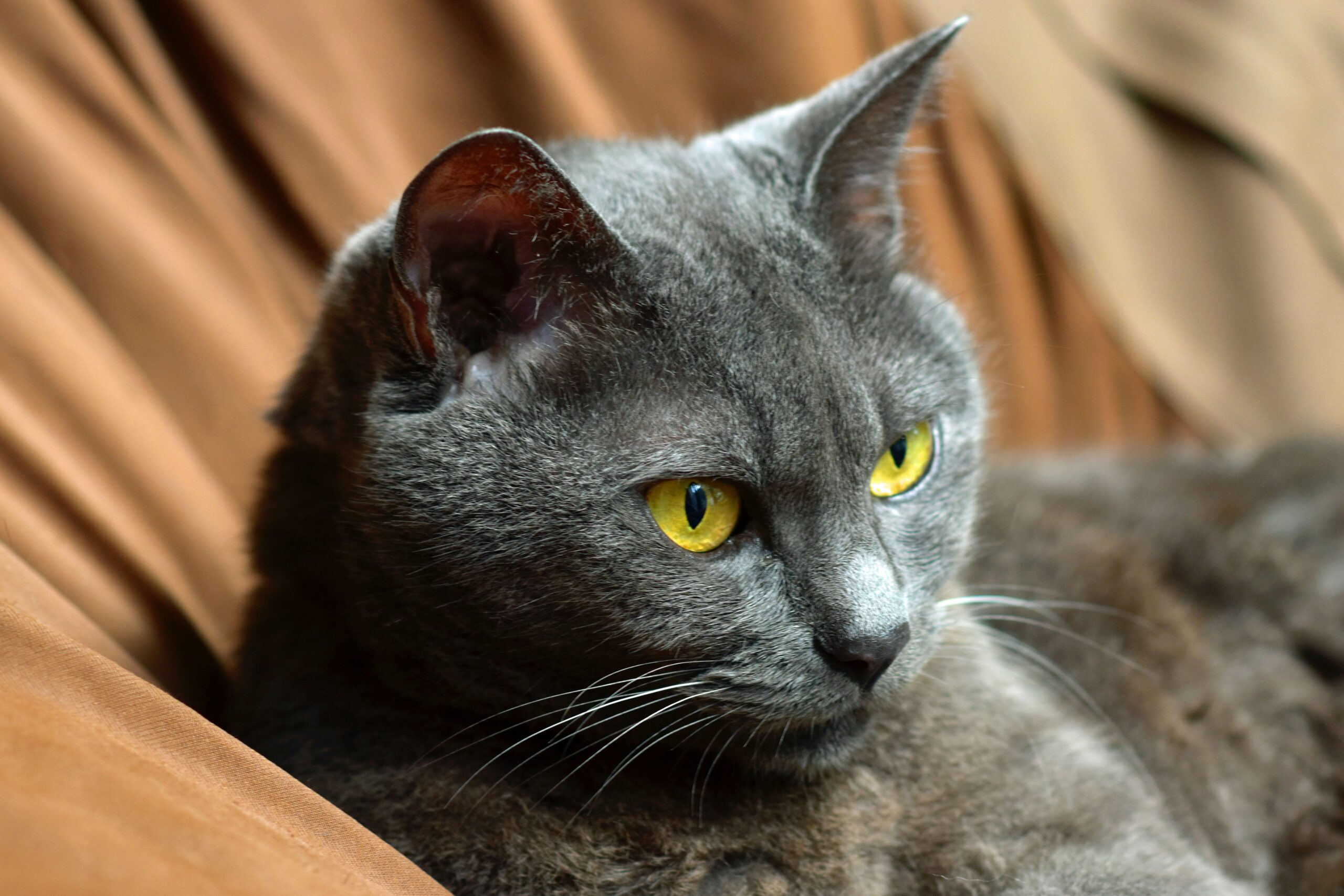If you’ve ever seen a Russian Blue, you’ll understand why they’re so captivating. With shimmering silver-blue fur, almond-shaped emerald eyes, and a graceful demeanour, these cats exude quiet sophistication. But beneath their elegant exterior lies a playful, affectionate soul—and possibly even a hypoallergenic secret.
Whether you’re curious about their temperament, health, or just wondering if they’re truly as allergy-friendly as people say, this guide will uncover everything you need to know about the majestic Russian Blue.
A Noble History Shrouded in Mystery
The origins of the Russian Blue are as mysterious as the cat itself. Believed to hail from the Archangel Isles in northern Russia, legend has it they were once the pets of Russian royals, admired for their beauty and grace. The breed made its way to England and Scandinavia in the 1800s, where it was further developed into the cat we know today.
Unlike flamboyant breeds like the Bengal or Savannah, the Russian Blue is reserved and poised. But don’t let their aloof expression fool you—they form deep bonds with their humans.
Temperament: Quiet Companions with a Soft Spot for Family
Russian Blues are known for their gentle, loving nature. They’re not as vocal as the Siamese, nor as clingy as the Sphynx, but they’re incredibly loyal and will often shadow their favourite person around the house—quietly, of course.
They tend to be shy around strangers but affectionate and playful in a familiar setting. While they may not jump into every guest’s lap like a Burmese or Ragdoll, once they trust you, they’re incredibly warm-hearted companions.
Many owners say their Russian Blue has a dog-like devotion. They’ll wait for you at the door, follow you from room to room, and curl up next to you on the sofa—but they’ll also give you space when you need it.
Intelligent, Playful, and Independent
Don’t let their quiet demeanour make you think they’re lazy. Russian Blues are highly intelligent and enjoy mental stimulation. They can learn tricks, play fetch, and solve puzzles just as eagerly as high-energy breeds like the Abyssinian or Oriental Shorthair.
They’re excellent climbers and love elevated spaces, so a tall cat tree or shelf is ideal. When left alone, they’ll entertain themselves without being destructive, making them ideal for working professionals or families with older children.
They’re also creatures of habit. Sudden changes in routine or noisy environments can stress them out. If your home is peaceful and predictable, the Russian Blue will thrive.
Is the Russian Blue Really Hypoallergenic?
Now for the million-rand question: Are Russian Blues actually hypoallergenic?
The short answer is: they’re better than most, but not truly hypoallergenic. No cat is completely allergen-free, but Russian Blues produce less of the protein Fel d 1, the common culprit behind allergic reactions in humans.
Combine that with their dense, short double coat that traps dander better than fluffier breeds like the Maine Coon, Persian, or Himalayan, and you’ve got a cat that many allergy sufferers can tolerate. Still, it’s best to spend time with a Russian Blue before adopting, just to be sure.
If allergies are a concern, other breeds worth exploring include the Devon Rex, Balinese, or Cornish Rex, all of which are known for producing less allergens.
That Signature Coat: Soft, Shimmery, and Easy to Maintain
The Russian Blue’s coat is perhaps its most distinctive feature. Short, plush, and silvery, it reflects light in a way that gives the cat a natural, velvety glow. Their fur is so dense it stands out from the body, giving them a luxurious, full appearance.
Unlike Domestic Longhairs, Munchkins, or Calico mixes, Russian Blues don’t require constant grooming. A once-a-week brushing is usually enough to keep their coat clean and healthy, especially since they’re known for meticulous self-grooming.
One bonus: they shed less than other double-coated breeds like the Siberian or American Shorthair, so they’re relatively low-maintenance when it comes to cleaning up fur.
Living with a Russian Blue: What to Expect
These cats do best in calm households. They’re not aggressive or mischievous like some Tabby Mixes or Oriental Mixes, but they can be wary of young children or hyper dogs. If you have a quieter home, perhaps shared with other gentle cats like the Scottish Fold, Birman, or British Shorthair, your Russian Blue will feel right at ease.
They’re adaptable but not overly social. Expect a cat who wants to be near you, not necessarily on you—although many will become lap cats once they bond deeply.
They’re ideal for singles, couples, or families with older kids who understand how to be gentle with animals. And because they’re independent, they won’t suffer terribly if you’re out during the day—as long as they have toys, scratching posts, and sunny windows to nap in.
Health and Longevity
Russian Blues are generally a very healthy breed, with fewer genetic issues than some purebreds like the Sphynx, Manx, or Exotic Shorthair.
They can live 15 to 20 years with proper care. Regular checkups, a balanced diet, and mental stimulation are key to keeping them happy and healthy.
Some lines may be prone to urinary tract issues or obesity, especially if they’re overfed or under-exercised. Be sure to feed them quality food in controlled portions and encourage regular play.
How Do They Compare to Other Breeds?
If you’re still weighing your options, here’s how the Russian Blue stacks up against some popular breeds:
- Quieter than a Siamese, but just as loyal.
- Less clingy than a Sphynx, but still very affectionate.
- More reserved than a Ragdoll, but with a deeper bond once earned.
- Cleaner than a Persian, with much lower grooming needs.
- More allergy-friendly than a Maine Coon, thanks to reduced allergen production.
- Less high-strung than an Abyssinian, but equally intelligent.
They’re a perfect balance between independence and affection, making them ideal for people who want a cat that’s loving without being overly demanding.
Common Myths About Russian Blues
Like many breeds, the Russian Blue comes with a few misconceptions:
Myth #1: They’re snobby or cold.
Truth: They’re just reserved around strangers. Once you earn their trust, they’re incredibly loving.
Myth #2: They’re all hypoallergenic.
Truth: They may be better for allergy sufferers, but no cat is 100% hypoallergenic.
Myth #3: They’re boring.
Truth: While they may seem calm, Russian Blues have a silly, playful side that comes out once they’re comfortable.
Should You Get a Russian Blue?
If you’re looking for a cat that’s elegant, low-shedding, emotionally loyal, and relatively quiet, the Russian Blue might be your perfect match.
They’re not the right fit for rowdy households or owners who want an extroverted pet like a Bengal, Savannah, or Tonkinese. But for those who appreciate quiet companionship, intelligence, and a bit of mystery, there’s nothing quite like a Russian Blue.
Before bringing one home, ensure you’re working with a reputable breeder or considering adoption. Russian Blues are sometimes mistaken for grey Domestic Shorthairs, so you may just find a hidden gem at your local shelter.
Final Thoughts: Quiet Royalty in a Fur Coat
Russian Blues are the aristocrats of the cat world—not because they’re aloof, but because they carry themselves with dignity, grace, and quiet affection. They don’t need to be the centre of attention, but they do want to be loved and included in your world.
If you’re looking for a low-drama, low-shed, and high-loyalty cat that will stay by your side for years to come, the Russian Blue may just be the crown jewel of your household.








